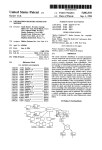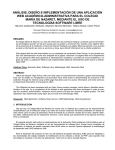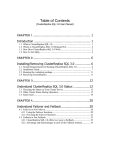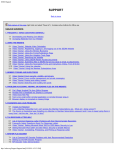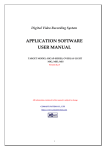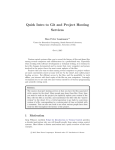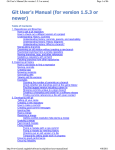Download this is a test
Transcript
Why so software engineeringy? Athula Balachandran Wolf Richter Are we really that serious? Actually, yes; yes we are. But we can have fun too! Case Study: from Industry Imagine you are a police officer on the road at 2:14am and there is a van weaving around on the road in front of you and it is obviously full of people who are dressed alike and have many different pieces of luggage and other objects that you can't quite see clearly in the vehicle. Mission critical applications? You reach over to your laptop mounted in your police car and key in the make model and license number and state. The message on the screen says: Sorry, this application is not available for the next 30 minutes. Just a short outage? You can imagine any possibility: - a church group on an outing, someone driving getting tired - a drunk driving his family - a smuggler bringing illegal aliens - a smuggler bringing in illegal drugs - or for the fun of it, a group of terrorists preparing a major attack What do you do now? You have no information from a mission critical system with access to all sorts of databases including who the owners of the vehicle are, who might have leased it, rented it, or is the main driver for it, and intelligence data bases that can tell you if it might be illegals or terrorists, or some other sort of criminal. As a single police officer who has to deal with this now, when backup is 20 minutes away and you do not know if these people will be armed and desperate enough to shoot first. Why? The reason the data is not available is that there was no backup that took over immediately on failure. We deal with this in many ways, short term with clustering servers, having mirrors or RAID for data, should data storage fail, network redundancy should a network connection fail. However, there may also be a deeper reason for the failure which is dealt with in another way; disaster recovery and above that COOP or Continuance Of OPerations should a major disaster occur. Netflix and the Chaos Monkey ● One of a few surviving AWS/EC2 outages ● Randomly fail running instances ● Randomly fail processes ● Randomly introduce network failures ● Execute rarely encountered code paths ● On the production system We'll be focusing on: Backups Code Documentation Source Control Management Code Structuring and Modularity Subversion: svn Usually remotely hosted, shared with a team. svn Repository svn commit Your private universe, before commit. svn checkout svn update Working Copy Getting started with svn Roll your own: ● ● svnadmin create repo svn checkout file:///.../svn/repo . Not your own: ● svn checkout https://... Types of Repositories Type Meaning file:/// Direct local disk access http:// WebDAV protocol via Apache https:// HTTP with SSL svn:// Access svnserve via custom protocol svn+ssh:// Same as svn://, via ssh tunnel Daily workflow with svn ● Check for any remote updates ● Do your work ● Test your work ● Check differences, try to isolate changes ● Check for any remote updates ● Commit your work Translated to svn commands ● svn update ● Checks for new commits in remote repository ● vim, emacs, make, create, magic, etc. ● make test (run your changes!) ● svn status ● ● See all changed files svn diff ● Understand differences line by line (like diff util) ● svn update ● svn commit -m 'Isolated changes x and y' Example repository > svn update At revision 0. > echo 'this is a test' > test > svn add test A test > svn commit -m 'added a test' Adding test Transmitting file data . Committed revision 1. > svn update At revision 1. > echo 'new text!' > test > svn status M test > svn diff Index: test =================================================================== --- test (revision 1) +++ test (working copy) @@ -1 +1 @@ -this is a test +new text! > svn update At revision 1. > svn commit -m 'updated text' Sending test Transmitting file data . Committed revision 2. Dealing with collaboration ● ● Lock-modify-unlock ● svn lock <path> ● Modifications... ● svn unlock <path> Copy-modify-merge ● Optimistically edit things ● Merge any files that others also commit Locking in Practice 1> svn lock test 'test' locked by user 'wolf'. 2> svn status --username 'blockme' -u O 2 test Status against revision: 2 2> echo 'i can have lock!?' > test 2> svn commit --username 'blockme' -m 'block on lock?' Sending test Transmitting file data .svn: Commit failed (details follow): svn: User blockme does not own lock on path '/test' (currently locked by wolf) 1> echo "maybe if you're nice..." > test 1> svn commit --username 'wolf' -m 'finished with test' Sending test Transmitting file data . Committed revision 3. Merging in Practice 2> svn update Conflict discovered in 'test'. Select: (p) postpone, (df) diff-full, (e) edit, (mc) mine-conflict, (tc) theirs-conflict, (s) show all options: Merging options Type Meaning postpone Mark conflict for later resolve diff-full Show all changes edit Use an editor to resolve mine-conflict Accept your version only theirs-conflict Accept their version only show Show more/all options svn Resources 1) svn help 2) svn book http://svnbook.red-bean.com/en/1.6/svn-book.html 3) svn Cheatsheet http://www.addedbytes.com/cheat-sheets/subversion-cheat-sheet/ git ● Fun, fun, fun! ● You already use it right? GitHub? ● If not, let's go down the rabbit hole... ● Resume padding ● Resume creator! git No notion of “working copy”–each is a full repository. git push git push kernel@ghub torvalds jaharkes git pull git pull git pull git push bgilbert git pull abalacha wolf git pull Getting started with git Roll your own: ● ● ● git config --global user.name “Wolfgang Richter” git config --global user.email “[email protected]” git init . Not your own: ● ● ● ● git config --global user.name “Wolfgang Richter” git config --global user.email “[email protected]” (1) git clone git://git.kernel.org/pub/scm/ git/git.git (2) git remote add origin [email protected]:username/Hello -World.git Types of Repositories Type Meaning rsync:// rsync client to git repo http:// HTTP hosted repo https:// HTTP with SSL git:// Special git server/protocol ssh:// git via ssh Daily workflow with git ● Check for any remote updates ● Do your work ● Test your work ● Check differences, try to isolate changes ● Commit your work; repeat as needed ● Check for any remote updates ● Push changes, or submit pull request Translated to git commands ● git pull ● Checks for new commits in remote repository ● vim, emacs, make, create, magic, etc. ● make test (run your changes!) ● git status ● ● git diff ● ● See all changed files Understand differences line by line (like diff util) git add ● Stage changes, potentially line by line ● git commit -m 'Isolated changes x and y' ● git push Example repository > git pull Already up-to-date. > git status # On branch master # Your branch is ahead of 'origin/master' by 1 commit. # # Changed but not updated: # (use "git add <file>..." to update what will be committed) # (use "git checkout -- <file>..." to discard changes in working directory) # # modified: src/recitation2.odp # # Untracked files: # (use "git add <file>..." to include in what will be committed) # # src/liso.c~ no changes added to commit (use "git add" and/or "git commit -a") > git diff diff --git a/recitation2/src/recitation2.odp b/recitation2/src/recitation2.odp index d3289ed..9a1fec3 100644 Binary files a/recitation2/src/recitation2.odp and b/recitation2/src/recitation2.odp differ Example repository > git add src/recitation2.odp > git status # On branch master # Your branch is ahead of 'origin/master' by 1 commit. # # Changes to be committed: # (use "git reset HEAD <file>..." to unstage) # # modified: src/recitation2.odp # # Untracked files: # (use "git add <file>..." to include in what will be committed) # # src/liso.c~ > git commit -m 'working on git section, also hello class!' [master 73d717b] working on git section, also hello class! 1 files changed, 0 insertions(+), 0 deletions(-) > git push Counting objects: 12, done. Delta compression using up to 2 threads. Compressing objects: 100% (9/9), done. Writing objects: 100% (11/11), 653.27 KiB, done. Total 11 (delta 3), reused 0 (delta 0) To [email protected]:theonewolf/15-441-Recitation-Sessions.git 2e7a763..73d717b master -> master Dealing with collaboration ● ● Branching – Cheap and effective ● Make development or feature branches ● Rebase and merge when features complete ● git branch https ● git checkout https ● ... Pull/Push with Merge ● Standard model: pull requests ● Or push into “central” repository Merging in Practice > git pull Auto-merging test CONFLICT (content): Merge conflict in test Automatic merge failed; fix conflicts and then commit the result. > cat test <<<<<<< HEAD helloX world ======= helloY world >>>>>>> 29a240d5017c73ca4f78466afcf1fd5b8f46808f Choose how to merge—yours or other author's. Finalize, commit, then push, or request a pull. svn vs git svn git Costly branching Cheap local branching No local repository Everything is local Large repos are slow Designed for very large repos Centralized Distributed Restricted workflows Multiple workflows http://whygitisbetterthanx.com/ git's Superiority It just is. Trust me. svn: every commit makes trusted code untrusted git: commit, commit, commit...; rebase; merge Extra git tips ● gitk – GUI to interact with git repository ● git svn – Use git on top of svn... ● git branch – create dev branches ● git tag – create release tag ● ● git bisect – binary search for bad commit git rebase – forward-port local commits git Resources 1) man gittutorial 2) Git User's Manual http://www.kernel.org/pub/software/scm/git/docs/user-manual.html 3) Git Immersion http://gitimmersion.com/ 4) Git Cheatsheet https://github.com/AlexZeitler/gitcheatsheet Code Structure: GNU make ● ● Recipes for your code ● Compilation ● Installation ● Cleanup ● Testing Composed of a series of ● targets [the recipes] ● which have dependencies ● and commands ● also, variables... Makefile from recitation1 ################################################################################ # Makefile # # # # Description: This file contains the make rules for Recitation 1. # # # # Authors: Athula Balachandran <[email protected]>, # # Wolf Richter <[email protected]> # # # ################################################################################ SERVER_SRC = echo_server.c CLIENT_SRC = echo_client.c OPTIONS = -Wall default: echo_server echo_client echo_server: @gcc $(SERVER_SRC) -o echo_server $(OPTIONS) echo_client: @gcc $(CLIENT_SRC) -o echo_client $(OPTIONS) clean: @rm echo_server echo_client GNU make Resources 1) GNU make Manual http://www.gnu.org/software/make/manual/html_node/index.html Wanna be “official”? ● Learn GNU autotools ● Standardize workflow with ● ● Generation of ./configure script ● Generation of Makefiles and make install target ● Generation of helper scripts Preparing to release open source? ● (1) Pick a license ● (2) autotoolize ● (3) GitHub ! #include #include #include #include #include Project 1 Sneak Peek <stdio.h> <stdlib.h> "select_engine.h" "http_parser.h" "logging.h" #define USAGE "\nUsage: %s <PORT> <LOG_FILE> <LOCK_FILE>\n\n" int main(int argc, char* argv[]) { int port; char* flog, * flock; } if (argc < 4) { fprintf(stdout, USAGE, argv[0]); return EXIT_FAILURE; } port = atoi(argv[1]); flog = argv[2]; flock = argv[3]; struct select_engine engine; liso_engine_create(&engine, port, flog, flock); liso_engine_register_http_handler(&engine, parser_http_handler); liso_engine_register_http_disconnect_handler(&engine, parser_disconnect_handler); liso_logging_log("liso", "main", "Starting Liso server on port %d", port); return liso_engine_event_loop(&engine); GitHub: Git it, got it, good. git clone git://github.com/theonewolf/15-441-Recitation-Sessions.git










































